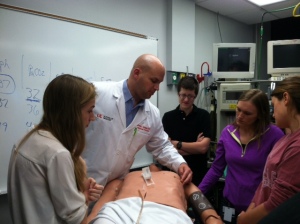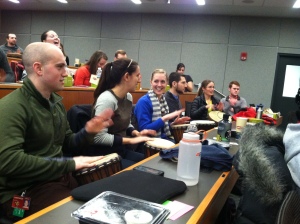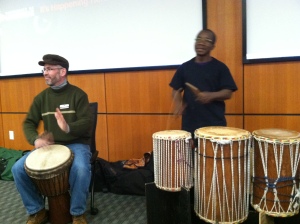Beth Seagraves Brooke, MS1
Along with a systems-focused curriculum, this semester brings new learning experiences. Though most days are still spent in our lecture hall, we now have days when we learn outside the classroom.
In problem-based learning (PBLs), groups of students gather to discuss clinical cases. The first dealt with an aortic dissection. Using information we learned in class, we discussed the patient’s vital signs, lab tests and scans. We arrived at a diagnosis and differentials. After listing several learning objectives, we agreed on a handful that we researched on our own that evening.
The following day, we shared what we learned and discussed the original diagnosis and eliminated differentials. We listed what symptoms were common among aortic dissections and aneurysms and what we, as future physicians, needed to be thinking of when ordering urinalysis, blood tests and X-rays.
I found the PBLs a laid back, fun way to practice using the information we’ve been learning this year. It’s also a great way to practice working with a team to arrive at a diagnosis and treatment plan for a patient. We have another PBL in a couple weeks integrating information on respiratory and renal systems.
We’re also spending more time in the Paris Simulation Center, which houses the school’s simulated patients. In small groups, we work with a Ph.D. and a M.D. to discuss a clinical case. The simulated patient’s physical status changes to mimic worsening conditions or improvement as we progress through the case.
Last week, since we were learning respiratory, we discussed pneumothorax.
Caption: Dr. Matthew Bozeman walks first year students through treatment of a pneumothorax.
The case centered around a patient who was struck in the chest during a soccer game. His blood pressure was dropping, his respiration rate was elevated and his O2 levels were down. Through each step, we discussed arterial blood gas (ABG) levels, metabolic panel and vital signs. We also used a stethoscope to hear diminished lung sounds on the simulated patient’s left side and discussed his X-ray.
The purpose of the simulations (SIM Lab) is to show us how the concepts we learn in class apply to clinical situations. It gives us an opportunity to think through the physiology of the patient’s case and gain a better understanding how the body responds to an injury, pathology or treatment.
Next to clinical rotations and preceptorships, it’s hands-on learning at its best.


